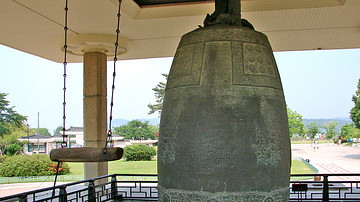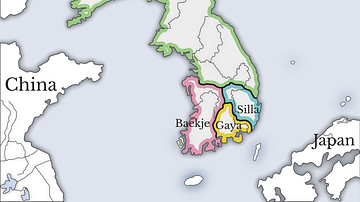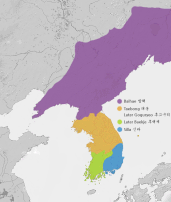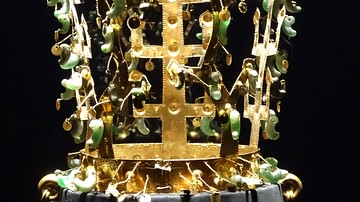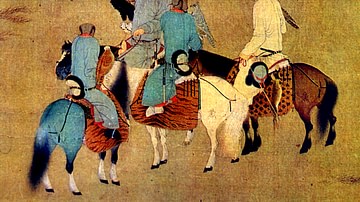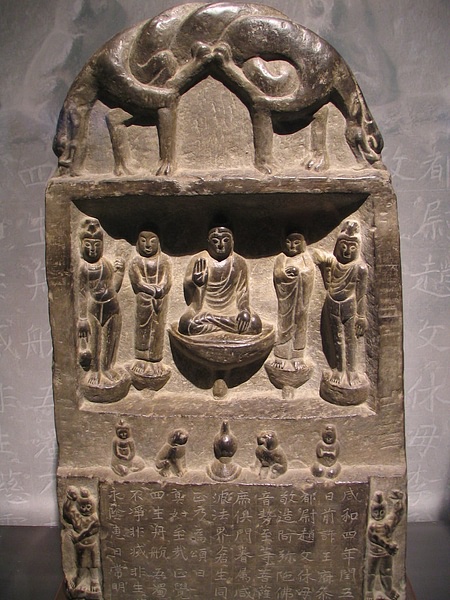
The Balhae (Parhae) kingdom in Manchuria (698-926 CE) was an important regional power which interacted both peacefully and otherwise with its neighbours the Unified Silla Kingdom of Korea and Tang China. The latter was a strong cultural influence, and Japan, too, was a staunch ally. The kingdom claimed to be the cultural successors to the earlier Goguryeo (Koguryo) kingdom of northern Korea and Balhae prospered for two centuries thanks to its rich agricultural lands and thriving trade relations. The kingdom collapsed in the early 10th century CE when it was attacked and conquered by the Mongolian Khitan tribe.
Foundation & Expansion
The kingdom was founded in 698 CE by Dae Joyeong (Tae Choyong), a former Goguryeo general of the semi-nomadic Malgal (Mohe) tribe of eastern Manchuria (although some modern Korean historians believe he was of Korean origin). The population was originally formed by exiles from the old Goguryeo kingdom (37 BCE – 668 CE) of northern Korea, which had been overtaken by the Silla kingdom, and members of the Malgal along with other groups like the Wuji, Khitan, and Eastern Turks. Dae Joyeong made himself king with the new name of King Go and reigned until 719 CE.
The state was named Balhae in 706 CE, after the sea around the Liaodong and Shandong peninsulas, with various cities acting as the state capital during the first half of the 8th century CE until the Supreme Capital (Shangjing/Sanggyong) was established in 755 CE near the Hurha River. Shangjing had impressive fortification walls and large palaces which had the Korean ondol system of underfloor heating and decorative roof tiles. There were four other secondary capitals, 15 lesser towns (pu) below these, and then a lower level of villages ruled by local headmen who reported to the various upper levels of centralised government which largely copied the Tang model. Five important roadways helped unify the kingdom.
The Yunghung and Daedong (Taedong) Rivers formed the border with Balhae's southern neighbour, the Unified Silla Kingdom of Korea. The period of these two nations is sometimes referred to as the North-South division (Nambuk sidae) or Era of the Two States. However, due to the fact that the Balhae territory largely covered lands outside of Korea (Manchuria and Siberia) and that its population was largely composed of various ethnic groups with only the elite claiming descent from historical Goguryeo, most scholars do not consider it a Korean state proper.
Balhae was squeezed between two powerful neighbours, the Unified Silla Kingdom and China, but this did not prevent it from pursuing a vigorously independent foreign policy. For example, Dae Joyeong's successor Mu (r. 719-737 CE) conquered the Hamhung plain and Hamgyeong coastal area from the Silla. This necessitated the latter building a series of fortifications to protect its northern frontier. In 732 CE Balhae even attacked by sea the Chinese port of Dengzhou as retaliation for Tang support of the troublesome Amur River Malgal tribe. In 733 CE the Silla kingdom, as it had done half a century earlier, formed a military alliance with the Tang Dynasty to try and quash a rival kingdom. This time, though, the northern mountains proved too hostile an environment and the joint Silla-Tang expedition failed with Silla losing half of its army amongst the snowy peaks.
Arts & Culture
The Balhae kingdom reached the height of its prosperity under Dae Insu (aka King Seong, r. 818-830 CE) when it expanded the territory under its control to the Amur River. The realm benefitted from the fertile agricultural land of the Manchurian plains and thus was able to support a population of around 500,000. Rice was difficult to cultivate in the colder climate, and so the most common crops were barley, millet and beans. Unfortunately, there are very few surviving artefacts or literature from the period, but we do know that the arts flourished, notably Balhae poetry, some examples of which survive, largely those taken by Balhae diplomats to Japan. Balhae also manufactured a prized purple porcelain. Tomb-paintings show a greater degree of Tang influence than Korean, although the tombs themselves – earth domes over a stone-lined chamber – are of Goguryeo origin. Such was the prosperity and artistic accomplishment in Balhae that in China the state became known as the 'Flourishing State East of the Sea'.
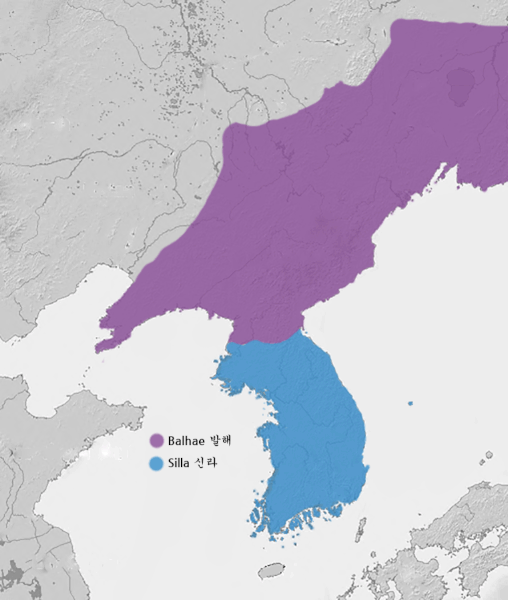
Foreign Relations
Despite the occasional breakout of hostilities, trade links were established with both of Balhae's immediate neighbours and with Japan. Such was the regularity of trade with its southern neighbour that a trade route with 39 stations wound down from Balhae to Silla. Diplomatic missions were sent by Silla in 792 CE and 812 CE. Cultural ties were also strong with China, as they had always been with Korea in general. Balhae exported metals and horses while China sent books and fine manufactured goods in return. Administration, laws, education, literature, and art all followed Chinese lines or displayed a marked influence. In return, Balahe sent students both for study and to enter the exams of the Tang administration. Buddhism was adopted, as it had been in the earlier Korean kingdoms, and Confucian principles were applied to the state's system of administration.
Japan, though, remained Balhae's staunchest ally with the Japanese sending 13 diplomatic embassies and Balhae 35 in return over the decades. Trade flourished with Japan exporting textiles and Balhae furs, silk, and hemp cloth. The two states plotted to invade Silla with a joint army. The first attack in 733 CE involved a large Japanese fleet but came to nothing, and the planned invasion of 762 never got off the generals' map board.
Collapse
In 926 CE, Balhae came to an abrupt end when it was conquered by the Mongolian Khitans. Balhae sent a plea for aid from their Japanese allies in 929 CE, but none was offered. The suddenness of the collapse is variously ascribed by scholars to the inherent social split between the elite of Korean descent and the local ethnic tribal masses, by the prolonged period of peace which preceded and perhaps softened the state and military, or even the devastating volcanic eruption of Baekdu which severely damaged the capital.
After the fall many of the Korean population fled south to Silla, but the Unified Kingdom was itself overrun by what became known as the Goryeo (Koryo) Dynasty. The latter claimed, as Balhae had done, that they were the true inheritors of ancient Goguryeo of the Three Kingdoms period (1st century BCE to 7th century CE) and proceeded to conquer all of the Korean peninsula, including the southern parts of the old Balhae territories.
This content was made possible with generous support from the British Korean Society.
